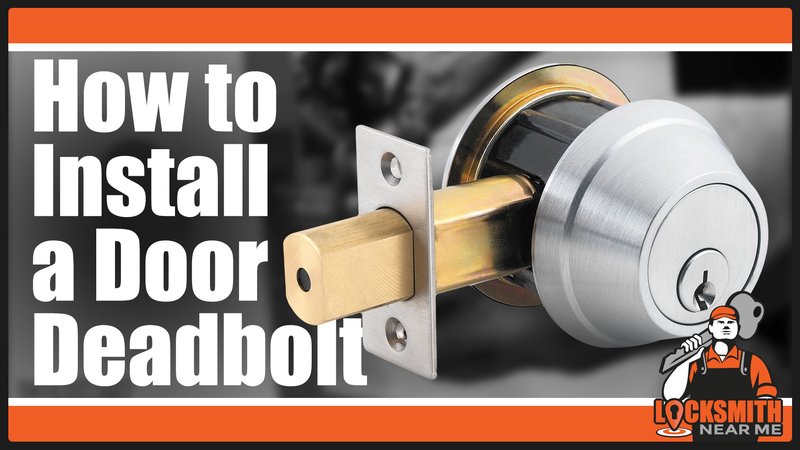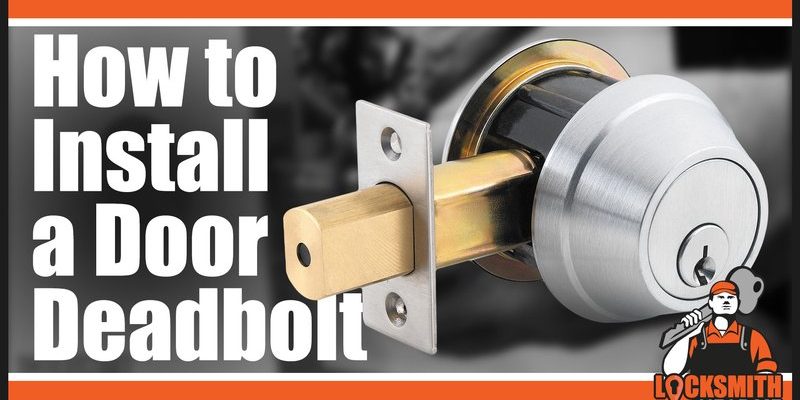
Here’s the thing: a door with a non-standard backset isn’t rare—especially in older homes or fancy, custom doors. But most of the deadbolt kits from names like Defiant, Yale, or even that slick smart lock you’ve been eyeing, are set up for standard backsets. It can be super frustrating, but don’t toss your new lock aside just yet. With a bit of patience (and the right info), you can get that deadbolt working—and keep your home secure—without calling a locksmith.
Let me walk you through what’s going on with these backsets, why it matters, and exactly how you can tackle installing a deadbolt—even if your door wants to break all the rules.
What Is a Backset? Here’s Why It Matters for Deadbolts
Before grabbing any tools, it’s worth taking a second to talk about *backset*. It sounds technical, but it’s really just measuring how far in from the edge of your door the lock sits. Think of it like the legroom in a car: if it’s off by even a little, nothing is comfortable—or, in this case, secure.
Here’s how it works. Most modern doors and deadbolt kits use either a 2-3/8″ or 2-3/4″ backset. That means if you measure from the door’s edge to the center of the big hole drilled for the lock, you’ll hit one of those two numbers. But older homes, fancy custom doors, or even some commercial doors might have something far off-standard—like 5″ (think old-school bank doors) or a quirky 2″.
If you try to install a regular deadbolt on a door with an odd backset, the latch won’t line up correctly with the edge, making the whole lock risky (and probably impossible to operate). That’s why double-checking this one little measurement is such a big deal.
Pro tip: Always measure your backset before heading to the hardware store, even if you think your door is “standard.” You’ll save yourself a second—or even third—trip.
The world of deadbolts isn’t “one size fits all,” and getting the backset right is hands-down the best way to avoid headaches later on.
How to Measure Your Door’s Backset (And What To Do If It’s Weird)
Let’s not overcomplicate this. To measure your backset, grab a simple tape measure. Place the end flush with the edge of your door (not the trim—the actual edge), and stretch it to the center of the circular hole where the lock sits. Read the distance in inches. If you get:
- 2-3/8″ or 2-3/4″: Congrats, you’re “normal.” Most deadbolt kits will work with one of these (many come adjustable).
- Anything else: Welcome to the land of non-standard backsets. Time to roll up your sleeves a bit.
You might be wondering—why do some doors have odd backsets? Usually it’s age, factory quirks, or custom design. Sometimes, specific brand locks used unique measurements. Either way, knowing your backset is your starting point before you even think about code, wiring, or anything “smart.”
If you find a 5″ backset, don’t panic. Brands like Schlage still make extended backset latches (often as a separate kit), but you’ll need to double-check compatibility with your chosen lock, especially if it’s a battery-powered or electronic model.
Knowing your measurement now will save you the pain of drilling new holes later.
Choosing a Deadbolt for a Non-Standard Backset: Brands, Latches, and Workarounds
Once you know you’re dealing with a non-standard backset, choosing a deadbolt that fits gets a little trickier. Most off-the-shelf options from Schlage, Kwikset, Defiant, and Yale are made for the two standard sizes. If you’re using a smart lock (say, a battery-powered Yale touchscreen or the newest remote-activated Schlage Encode), you need even more care—these often don’t have non-standard latches at all.
So what’s your move? Here are some options:
- Extended Latch Kits: Some brands offer separate (often hard-to-find) latch kits for 5″ or other non-standard backsets. For example, Schlage has a 5″ latch you can buy. You just swap it in for the standard one in their deadbolt kits—double check model compatibility though.
- Universal Deadbolts: There are a few “universal” deadbolts made for oddball backsets. They’re not as common, and finish/style options may be limited. Worth a look if you want less fuss.
- Re-drill or Modify: Not the most beginner-friendly, but sometimes you can plug and redrill your door for a standard backset. This is tricky, can look bad if you’re not careful, and may weaken the door around the lock. Honestly, it’s best avoided unless you’re desperate.
Here’s the thing—if you want code-entry, remote, or battery-powered “smart” features, check with the brand’s website or support for non-standard latch support. Most smart locks nowadays aren’t built for custom backsets, but brands update their accessories all the time.
Step-by-Step: Installing a Deadbolt with a Non-Standard Backset
Ready to tackle the actual install? Take a breath. The process is *almost* like a standard deadbolt, but there are a few crucial tweaks because of your backset.
What you’ll need:
- Your chosen deadbolt kit
- Extended latch (if required)
- Phillips screwdriver
- Tape measure
- Pencil
- Drill (with wood bits, if any resizing is needed)
Here’s how it usually goes:
- Remove the Old Deadbolt
Start by unscrewing the inside faceplate and exterior cylinder. Pull both sides out gently, then take out the latch from the edge. - Check the Hole Alignment
Measure and confirm your backset again. If you’re using an extended latch, set it next to the old one to be sure lengths match up. - Install the New Latch
Insert your non-standard latch into the door edge, making sure it’s snug and flush. Secure it with the screws provided. If there’s wiggle or the faceplate doesn’t sit right, you may need to adjust the mortise slightly (a wood chisel helps here). - Attach Exterior and Interior Plates
Line up the outside cylinder and inside thumb turn. Thread the connecting rods through the latch, making sure they move freely. Hold everything straight (it helps to have a friend double-check from the outside). - Secure and Test Fit
Tighten all screws, but don’t overdo it—you don’t want to strip anything. Before closing the door, turn the deadbolt to check for smooth action. If it sticks or grinds, loosen, realign, and try again.
If everything feels tight and smooth, you’re golden—your new deadbolt is set to secure your door, even with that quirky backset.
Troubleshooting Common Problems With Non-Standard Backsets
Let’s be real—sometimes a non-standard backset throws a wrench into things, even if you follow every step to the letter. Here are a few problems beginners run into, and how you can get past them.
- Latch Won’t Fit: If your new latch is just a little too long or short, double-check that you’ve got the right part from the brand. Occasionally, the supplier sends a standard size by mistake, or there’s a packaging mix-up.
- Deadbolt Doesn’t Lock Smoothly: Maybe it turns halfway and gets stuck, or you have to jiggle the key. This usually means the latch isn’t sitting square, or the hole through the door isn’t perfectly straight. Loosen the plates, realign, and try again.
- Batteries, Codes, or Sync Issues (Smart Models): For electronic deadbolts, always check the battery compartment before final install. Code entry and remote sync problems can sometimes be fixed by resetting the lock or re-pairing the remote. Each brand (like Schlage or Yale) will have their own steps for this.
Don’t force anything. If it doesn’t fit after a few adjustments, pause. Sometimes it’s better to stop, step away, and review the instructions—or even call the brand’s support line for help. No shame in asking.
Why Getting the Right Deadbolt Matters for Security (and Peace of Mind)
You might be tempted to settle for a “close enough” fit. Honestly, don’t. A deadbolt that’s not lined up with your door’s edge, or has a wobbly latch, can make your door easy to pry open. A good deadbolt—properly installed for the right backset—keeps your home safer.
Besides, a properly aligned deadbolt will last longer. If there’s tension or if you have to force it, you’ll wear out the internal parts, burn through batteries on a smart lock, and risk being locked out when things finally jam up. Plus, if insurance ever needs proof of “reasonable security,” a professional-standard install is always best.
A quick reality check: doors, frames, and lock brands don’t always play nice together. But with the right latch for your door’s true backset, you’ll avoid costly future repairs and get the real security those brands promise.
Alternatives and Extra Tips if You Can’t Find a Matching Deadbolt
Let’s say you’ve checked every hardware store, called the brand, and still can’t snag a deadbolt for your ultra-weird backset. What are your options?
- Special Order From Locksmiths: Local locksmiths often have access to rarer latch kits, or can recommend commercial-grade solutions brands don’t sell at big box stores.
- Add a Second, Standard Deadbolt: If you don’t mind an extra hole in your door, install a second deadbolt at a standard backset. You’ll patch or cover the old hole, but it’s a secure workaround.
- Surface-Mount Deadbolts: These attach to the inside of the door and don’t rely on the existing borehole. Not as sleek, but they work when nothing else fits—and they’re available in code or battery-powered versions, too.
Whatever you decide, avoid “adapting” latches that aren’t designed for your backset—forced fit is a recipe for big trouble.
Final Thoughts: Installing a Deadbolt on a Non-Standard Backset
Tackling a deadbolt install when your door has a non-standard backset can feel like a puzzle with missing pieces. But now, you know what to look for—and why it matters. Whether you’re swapping in a classic Schlage, upgrading to a Yale smart lock, or finding a universal solution, the trick is matching the latch to your door’s quirks, not the other way around.
Slow down, measure carefully, and don’t settle for “good enough” when it comes to your home’s security. If you’re patient, double-check everything (and maybe call in a pro if you’re stumped), you’ll end up with a sturdy deadbolt that keeps your home safe—and your DIY confidence intact. Happy installing!
